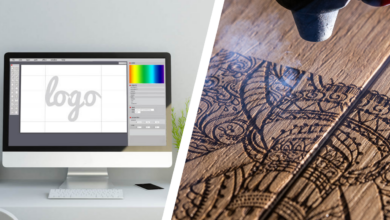The past few years have brought about a lot of changes to the workforce, particularly for those involved in creative sectors.
As we move into 2023, there are four trends we can expect to see affecting designers: the rise of AI, a more holistic mix of feelings and facts, increased creative collaboration, and greater accessibility in design.
Enhancing creativity with AI
In the digital world, artificial Intelligence (AI) is quickly becoming a normal part of the creative workflow — and in many cases, designers are already using AI in their software without even being aware of it.
With more creative software programs embracing AI, designers are now equipped with a powerful tool that enables them to work, ideate, and create better. AI helps to enhance design by boosting productivity. It helps people to break from their usual aesthetic, try a new style, and source new creative inspiration while also reducing tedious, manual tasks in the workflow.
While big changes and innovation are often met with skepticism, the scope for innovative, creative possibilities that AI brings to the design world is endless. This is an exciting space that savvy industry leaders will need to watch closely in 2023.
Bringing together the feelings and the facts
Designers today have access to huge amounts of data, equipping them with a better understanding of the performance of their work with measurable results. Insights into customer behavior inform the design process leading to more data-driven decisions; however, this focus on data does not mean that designs today lack human empathy and creativity.
To create compelling work, designers must strike a balance between data-driven and intuition-led design. They need to be experts in understanding human behavior, know when it’s best to lean on the data, and when they should trust their instincts, think outside the box, and take creative risks.
To create great designs and foster strong connections with customers, designers must not only embrace this data-driven world but also learn how to balance analytics with their own intuition and creative judgment.
Driving creative collaboration
The way people work has completely transformed. Today, people work in a mix of remote, hybrid, and in-person environments. For years, leaders believed that in-person work yielded greater collaboration and that creativity happened within the bounds of the traditional 9 a.m. to 5 p.m., Monday through Friday work structure. We’re now seeing that this isn’t the case. Designers can collaborate, be creative, and drive innovation anytime and from anywhere — whether that’s from a coffee shop or the couch at 2 a.m.
There’s been an influx of design tools that allow for remote collaboration, enabling people to connect with teams and clients regardless of location. This ability to seamlessly create from anywhere will only become increasingly important as more people lean into new ways of working. Empowering people with the freedom and flexibility to work how, when, and where they want leads to better productivity and more opportunities for creativity.
Prioritizing accessible web design
In the U.S., 26% of adults have some kind of disability. This means that millions of people do not have adequate access to information, services, and products because many websites’ designs inadvertently exclude them.
In 2023, we expect to see more of an effort to optimize web accessibility. Making design more accessible can be the use of visuals that represent race, gender, and orientation diversity, but it also takes into account things like typography and font size, subtitles in videos, high contrast visuals, and using clear and concise copy. When accessibility is prioritized, people with mobility, cognition, hearing, and vision impairments are better able to perceive, understand, navigate, and be full participants in our digital world.
The future of graphic design
The way we work and create is always evolving. It’s an exciting time for the digital design space, as we can expect to see major shifts around AI, data analytics, creative collaboration, and accessibility in the coming year.





